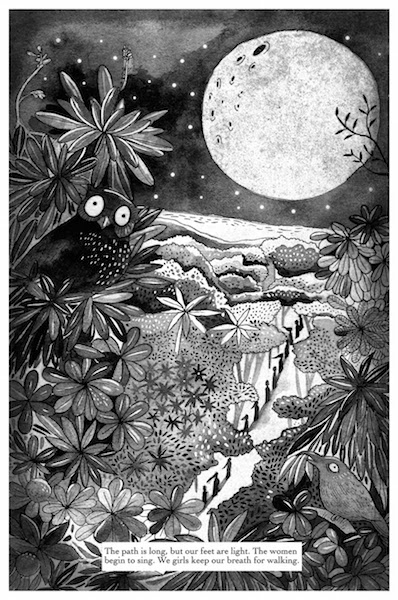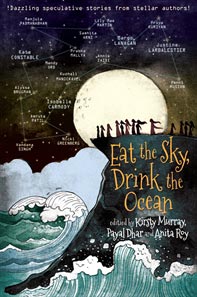Eat the Sky, Drink the Ocean is a collection of speculative fiction feminist shorts that brings together writers, illustrators and editors from India and Australia—some of whom had never met before they collaborated. It’s a wonderfully diverse collection of six illustrated stories, a play and ten short stories, some of which are a collaborative effort and some which were written independently but workshopped with other writers in the anthology.
Edited by Anita Roy, Kirsty Murray and Payal Dhar, Eat the Sky emerged as a response to a number of violent incidents against women that took place in both India and Australia in 2012. The stories imagine a different world—sometimes one in the future, sometimes an alternate vision of the past and sometimes very much in the present. Each story is a look at what life is for a girl or a woman, whether in this world or an imagined one.
The first story in Eat the Sky, Drink the Ocean is the richly illustrated Swallow the Moon by Kate Constable, Priya Kuriyan drawings bring to life a narrative about sisterhood and rites of passage. A group of young girls walk barefoot through a dark forest, each carrying ‘a tiny bundle, wrapped in skin, and secret’. They reach the ocean, where the beach is marked with the ‘tracks of seabirds, the secret writing of the gods’ and they dive into the water, searching for the lost city and for their true names. But things are not quite so simple, not quite so rosy. The girls, however, understand why things are as they are, and what they will need to do for those who come before them. It’s a dark story made joyous and easier to swallow only by the great illustrations that accompany it.

Rites of passage and coming of age themes are sprinkled through the collection, more often than not featuring a young woman who finds and begins to understand her own power and her own agency. In Little Red Suit, Justine Larbalestier explores a dystopic vision of Little Red Riding Hood in which a young girl must go to grandma’s place and risk facing the worst wolves of all—those who are human. In Margo Lanagan’s Cat Calls, a young woman faces wolves too, but in the form of a group of men she has to walk by every day. It is a tight, focussed story about gendered street harassment, in which the young women come together to publicly confront the men who try to humiliate them, forming a bond that goes beyond maturity and sisterhood, a shared experience that turns the tables and leaves a strong impact on all involved.
Another young woman who comes into her own is the protagonist of Annie Zaidi’s Anarkali, a graphic story illustrated by Mandy Ord about the famed Mughal court dancer whose only crime was a relationship with Prince Salim. The Emperor did not want his son cavorting with a dancing girl and so had Anarkali entombed alive. Trapped in stone, Anarkali listens to her true voice: ‘once you tackle this wall, all walls will yield’. As ‘a white heat rises under her feet and travels up into her body and head…It is as if she has been struck by lightening. Rivers crawl under her muscles. Stream press out of her nostrils. Her eyes are a furnace.’ Anarkali finds that she is able to walk in the walls,—not just through them but in them—to reach Salim and to force him to listen too, to the ‘whispering of the earth’. It’s a charming tale, with vivid, wood-cut like illustrations and while Salim seems to be a total idiot, Anarkali is strong and fierce.
Eat the Sky, Drink the Ocean also has stories that talk about the power of womanhood, of female strength and ability to withstand adverse societal threats. In Cast Out, Samhita Arni creates a world in which girls are not allowed to practice magic. If caught doing so, they are lashed, put in a barrel and sent out to sea where ‘demon clouds’ endanger every exposed boat or ship. Boys who do magic are trained as sorcerers and used to protect the ships that trade between the continents, but what happens to the young girls sent away? Are they lost or are the able to use their abilities to create a better world for themselves and others like them?
Another story that stands out also touches on the idea of growing up and what that can entail. Khuzhali Manickavel’s strange little dream The Wednesday Room has art by Lily Mae Martin and is about a young girl belonging to a clan who contain supernatural elements or rather ‘substandard aberrations’ in society into a room that has been landscaped for the needs of these element, be they mermaids or unicorns or vampires. But young Kavya is about to be ‘standardised’, and when she is, all the ‘aberrations’ will vanish. It’s a lovely, dark little story with appropriately dark visuals about choosing to fit in—or choosing not to fit in.
Eat the Sky, Drink the Ocean may be speculative feminist fiction, but the collection also has socio-economics concerns, and looks at gender imbalances, capitalism, ecological damage and even female infanticide. It’s really very worldly in it’s approach, covering a great deal of ground and a great many sub-genres. From dystopian worlds and nuclear powered fairy tales, to time travel cooking shows and girls who can live inside inanimate objects and legendary Mughal beauties, it’s really a great little collection and something well worth reading. It’s published by Zubaan Books in India and Allen & Unwin in Australia.
Mahvesh loves dystopian fiction & appropriately lives in Karachi, Pakistan. She writes about stories & interviews writers the Tor.com podcast Midnight in Karachi when not wasting much too much time on Twitter.











I’m reading this now and it’s a very nice short, sharp collection so far.